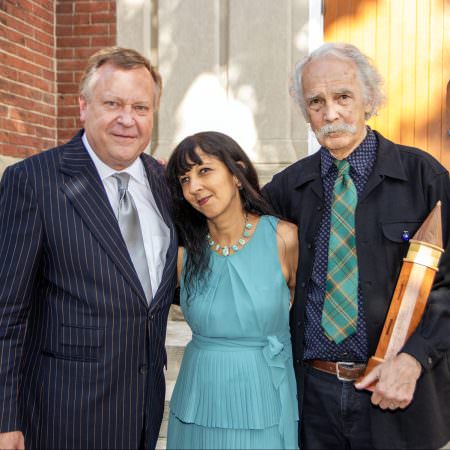Henry Glassie Receives Williamson Prize from Indiana Landmarks

In recognition of his trailblazing work helping generations find value in humble historic buildings, renowned folklorist Henry H. Glassie received Indiana Landmarks’ 2024 Williamson Prize for outstanding leadership in historic preservation at their annual meeting in Indianapolis on September 7.
“More than anyone else, Henry has contributed to our knowledge of vernacular architecture and material culture, vastly broadening the scope of historic preservation,” says Marsh Davis, president of Indiana Landmarks. “He understands buildings the way an anthropologist would, using clues in buildings’ forms to point to their cultural and geographic origins. Many historic buildings would have been otherwise lost if Henry had not taught us what they are and why they are important.”
Glassie conducted fieldwork to study housing and material culture in Turkey, Ireland, and India as well as the United States. Over his lifetime, he has published extensively on a variety of subjects, including vernacular architecture. He is best known in historic preservation as the author of seminal texts Vernacular Architecture, Pattern in the Material Folk Culture of the Eastern United States and Folk Housing in Middle Virginia. His study of humble, rural properties laid the groundwork for nominating rural historic districts to the National Register of Historic Places. He collaborated with Indiana Landmarks to successfully nominate Maple Grove Road in Bloomington—Indiana’s first rural historic district—to the National Register.
He played a hands-on role promoting preservation in Bloomington, where he helped restore six houses, served on the Bloomington Historic Preservation Commission, and chaired the board of local historic preservation nonprofit Bloomington Restorations, Inc. In the 1970s, he also helped survey the city’s historic structures, identifying buildings in need of preservation and laying the foundation for zoning ordinances to establish a downtown historic district. As a professor, he led students on walking tours to show them historic patterns of housing and industrial architecture.
“I have spent a life that has incorporated a lot of things but mostly I’ve spent my life with people of modest means in backcountry places, and my work in vernacular architecture has had some influence on historic preservation,” notes Glassie. “I take pride in this award being given to someone who has committed himself to that kind of work, attending primarily to forgettable buildings which are more creative to me from an artistic standpoint than big fancy buildings.”
We sometimes make mistakes, and we are happy to correct any errors that you may come across on our site. If you find an error, please let us know using the “submit a correction” link.